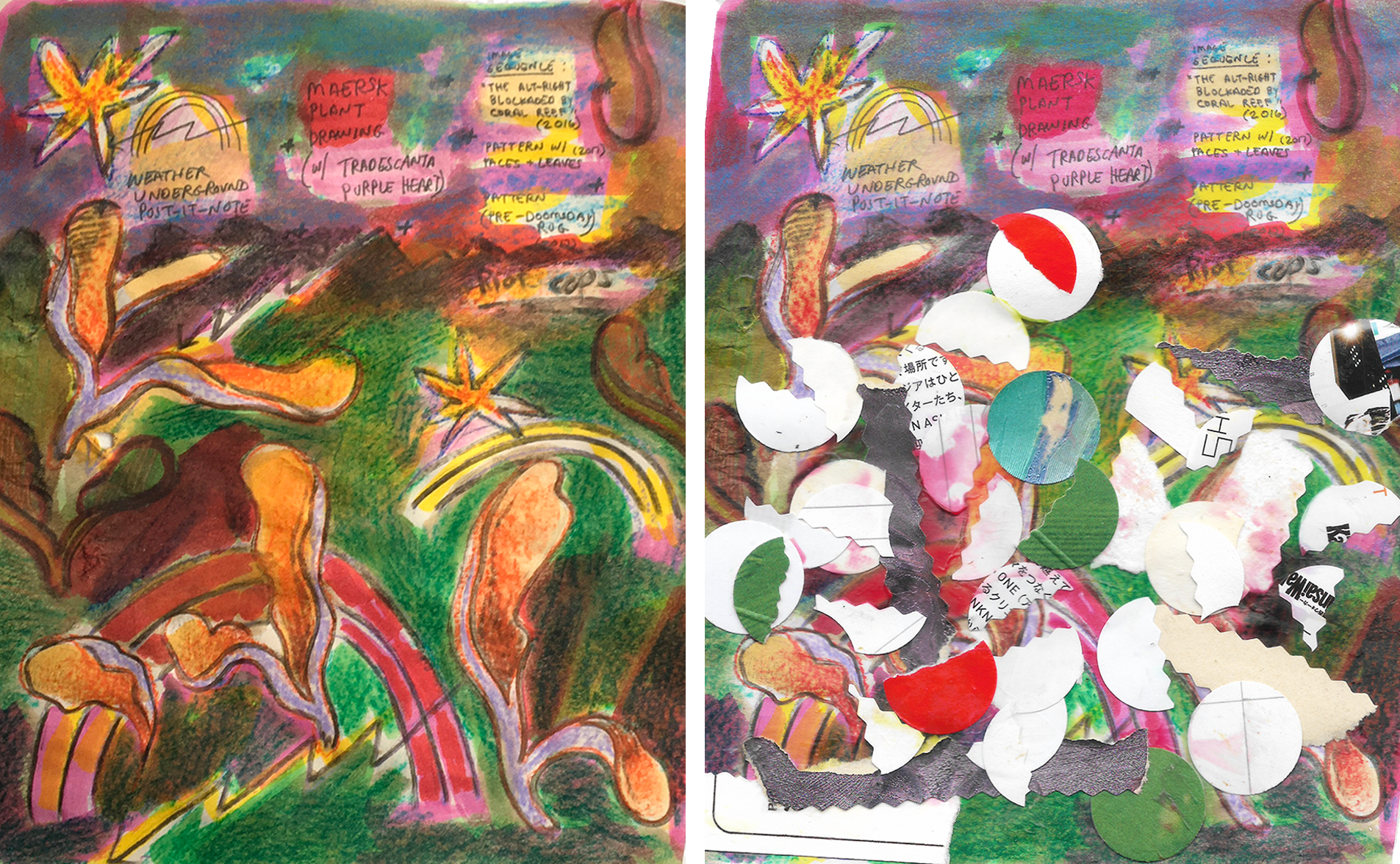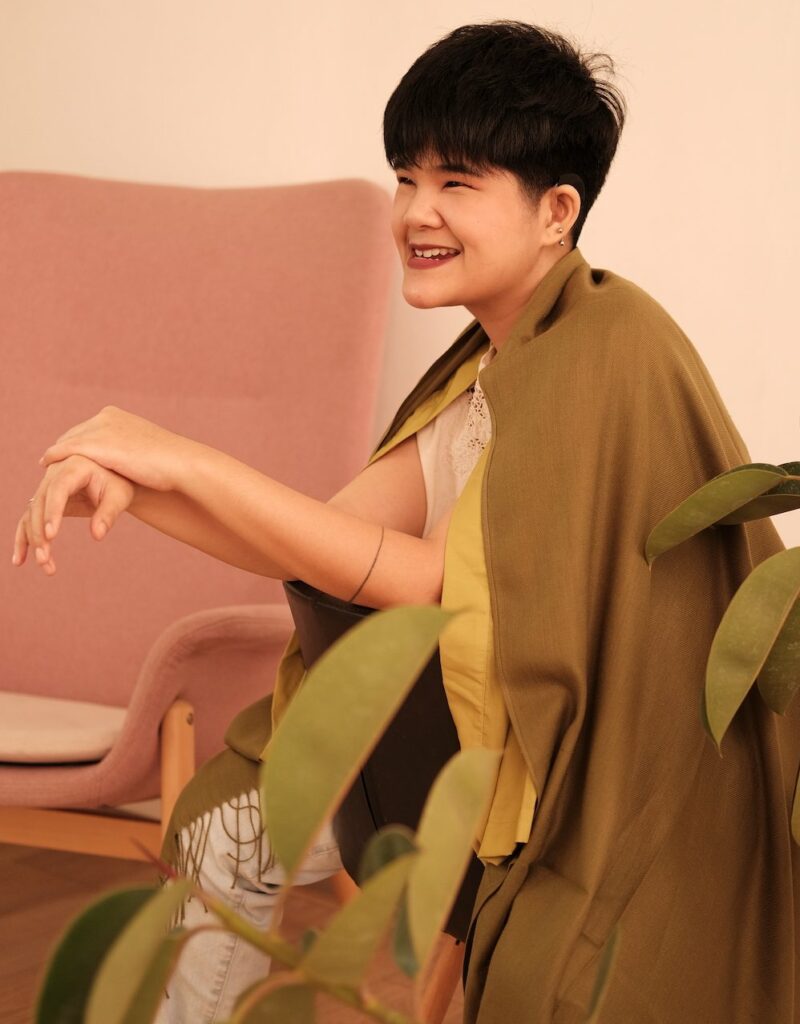
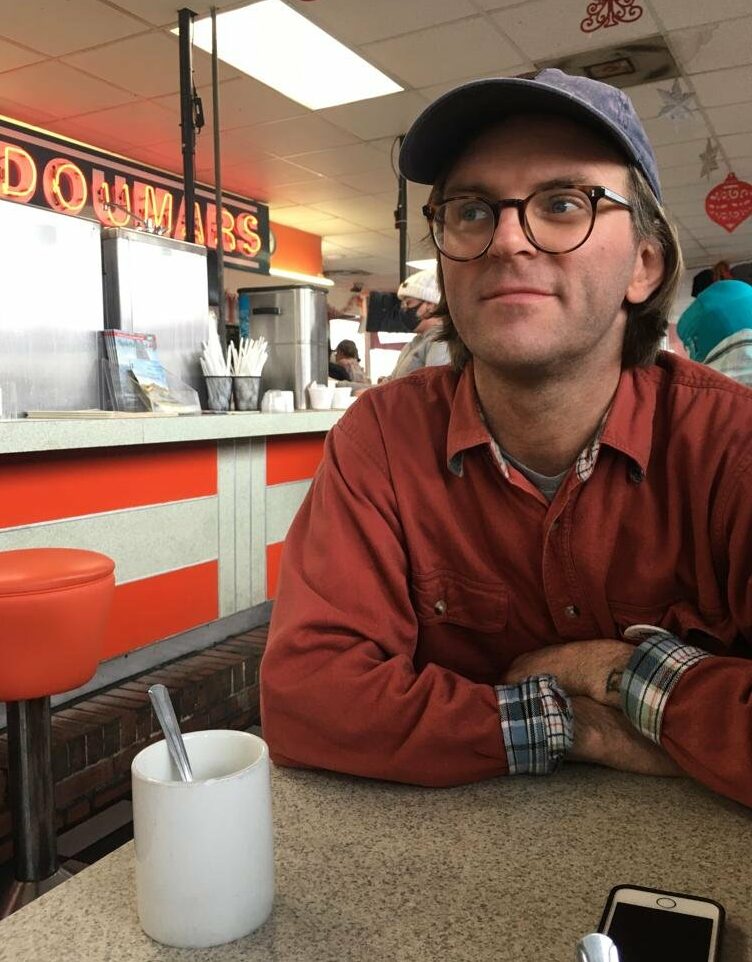
KARIN JOSEPHINE
For years, Karin has cut, torn, rip and peeled off discarded papers for her collages. The underexposed surfaces composed with colours or other objects are often resulting in open-ended artworks. They have their own distinctive look and unpredictable beauty for it.
By delving through the layers and rips of discarded papers, she found out that it heals and is therapeutical at the same time. Karin views her works as a way to entangle minds as well as depict the chaotic world inside one’s mind beyond words.
Being a person that is Hard of Hearing (HoH) and with Tinnitus (constant ringing inside one’s head), doing collage now helps Karin more than ever; to train the mind, manage expectations and accept things as it is—as well as advocate for herself.
Projects and exhibitions include: group exhibition with STEM Project under Srisasanti Syndicate, Yogyakarta, Indonesia (ongoing until 11th December 2022); Re-archive, a mini residency by IVAA (Indonesia Visual Art Archive), Yogyakarta, Indonesia; DICE (Developing Inclusive & Creative Economics) x Ketemu Project; Unknown Asia 2018 Art Fair in Osaka, Japan; group exhibition in Stein Egerta, Liechtenstein.
CHRISTIAN NEWBY
Christian Newby is an artist and researcher whose work includes ways in which the conventional implementation of applied arts and design techniques can and are being resisted and recast; subverted away from hierarchically adverse roles of artist, designer, publisher and fabricator. What new idioms can we devise from conventional tools and techniques by misusing, re-wiring—by the experimentalism of the amateur’s hand, and by the terminus of the finished artwork? What can we learn from textiles as a form of activity rather than as decorative artefacts? How can DIY publishing further elucidate this formation through a diverse register of voices, stories and didactic instruction? He draws a first-person line around the jetsam of art and craft production. His work summons the role of the mark-maker, the textile fabricator, the diarist, zine-maker and hobbyist. It is a practice that integrates personal conflicts with material experimentation and plots a course of reflective experimentation, encountering tools and techniques rather than simply applying them.
He received his B.A. in Sculpture and Extended Media at Virginia Commonwealth University in 2002, an M.F.A. at the Glasgow School of Art in 2009, and in 2022, completed his PhD at Kingston University’s Contemporary Art Research Centre.
Listen
Pit Stop | Mari Mampir
Process, mark-making, rambling, and nonsequitur are the key themes that emerged during the collaboration between artists Karin Josephine and Christian Newby. What became particularly exciting about this collaboration was the shared openness and enthusiasm by the artists for their own artworks to be manipulated by the other. From selecting printed ephemera from their respective transnational cities to their idiosyncratic mark-making, Karin and Christian profoundly embraced intuitive creativity.
Over 6 Zoom meetings a framework for their project, Pit Stop: Mari Mampir, emerged. Karin and Christian both developed a body of new work during the initial phase of the collaboration. Karin, whose practice often involves book-binding, produced a handmade book. This bound sketchbook was made of pages from a variety of sources, all indicative of Karin’s life and local environment. One page appears to be a ‘Surat Perjajan’ (Letter of Agreement) adorned with doodles, while another page features a collage of tomato can labels and layers of her signature cut circles. Christian made a series of works on paper from an array of found materials and news sources like the UK’s Guardian Newspaper. He also applied patterns, text and figures to select works. One of his drawings (see Ramblings below) becomes emblematic of Pit Stop: Mari Mampir with the names ‘Karin’ and ‘Christian’ boldly scribed in hues of magenta, with an intimate Venn diagram composed in the centre.
These series of works made in response to the collaboration were sent internationally for each artist to respond, edit, and add to the other’s initial creations: Christian’s works on paper, often incorporating British periodicals arrived in Indonesia to be further developed by Karin, and her book of Indonesian documents and collaged photocopies made their way to London for Christian. The outcome is the essence of collaboration, a book composed of the pages contributed to by both artists. A collection of layers embodying their artistic processes, Pit Stop: Mari Mampir, made from computerised scans, also emulated the layering of the physical and the digital of this collaboration, communication, and creativity.
Listen
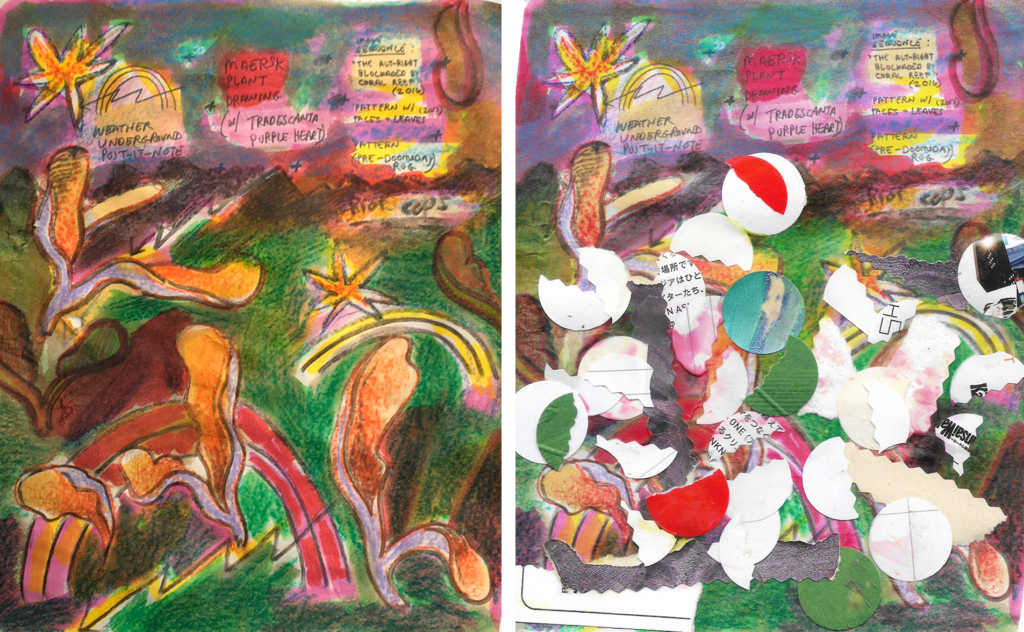
Is this your first international collaboration with an artist?
Karin: Technically, this is not the first one. I have done a collaboration project with a collage artist in the US so long ago, but it was not as interactive as this project.
Christian: I think so, but I’ve done a few things in the past couple of years with a publishing collective where we work within similar geographical restrictions, albeit not as far away as Indonesia.
How did you decide what to make and select to send the other artist?
Karin: From his works and after several Zoom meetings, I can see we are connected by the sense of mark-makings. The feelings of tangible things and delving into the process is somehow connecting us. Through meetings and chats, it seems like the best way to expose both parties’ works is through physical books that can be explored by the audience.
I’m used to working intuitively, so when working for a certain project/a more organized format I make some ‘corridors’ for me so it would be less messy. I sort some materials and working base (in this project, the junk journal) to narrow down the options then I start focusing on it. During this project I was also in a big mood for binding books, so the junk journal was one of the binding projects. In one of our e-meetings, Christian mentioned about local newspaper as a significant point of location and date. That inspires me on what to collage inside the journal; to stick on certain used packaging/ labels, combined with the journals that used old papers from my old projects. I also send Christian one of my national newspaper so he can work on it.
Christian: We both seemed to be driven by tactile surfaces in the things we often make. Making an artist’s book seemed like a good way to still make an object or something to hold in your hand, but also something that serves as a document of a process–something that could account for the similarities, diversions and the general awkwardness of making something with someone so far away, someone you just met (virtually).
I chose to send Karin newspaper cuttings that I painted on top of. The broadsheets gave me a structure and grounded the images to a specific place and time.
Process
Karin: the most essential part of doing
Christian: accumulation and cultivation
Mark-making
Karin: very personal way of portraying/recording the feelings (through visuals or writings)
Christian: traces, shadows of the body thinking and doing
Rambling
Karin: rants, undefined ideas
Christian: improvising, not in search of a defined terminus
Nonsequitur
Karin: abrupt fragments — eventually connecting each other somehow
Christian: breaks, shortcuts through a broader network of logic-making
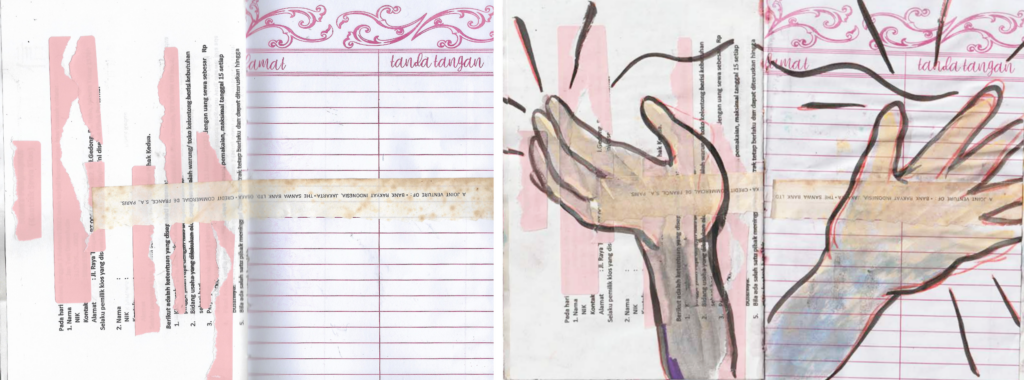
Ramblings
A selection of free-form writing composed by Karin during this collaboration, paired with works on paper by Christian.
Listen
If the brain is a home with many rooms, mine might be that one with messy rooms and crowded storages. Only certain drawers are placed properly, while others are complete chaos and disorganised. When I try to tidy things up, I have no idea what goes where, or how to keep it organised for longer than a month.
…ok, bad starter for any writing submission. Haha.
That was me ruminating.
I didn’t stop doing this thing called “ruminating” until 2 years ago. While the actual word has a positive meaning, in my case it’s not a good thing to do. It’s the worse version of overthinking. I used to overcomplain myself for some minor mistakes I do, which brings no good at all. After I learned the concept of attachment and back to journaling habits (which were a bit absent before), I started to view myself and those around me in a brighter light.
“Healing” and “mindfulness” have never been quite a word in my journey. Its overrated use in the current social media scene only makes it sound more superficial than it should, maybe because of that I feel reluctant to relate to those words even though I connect my art practice to those terms.
Karin
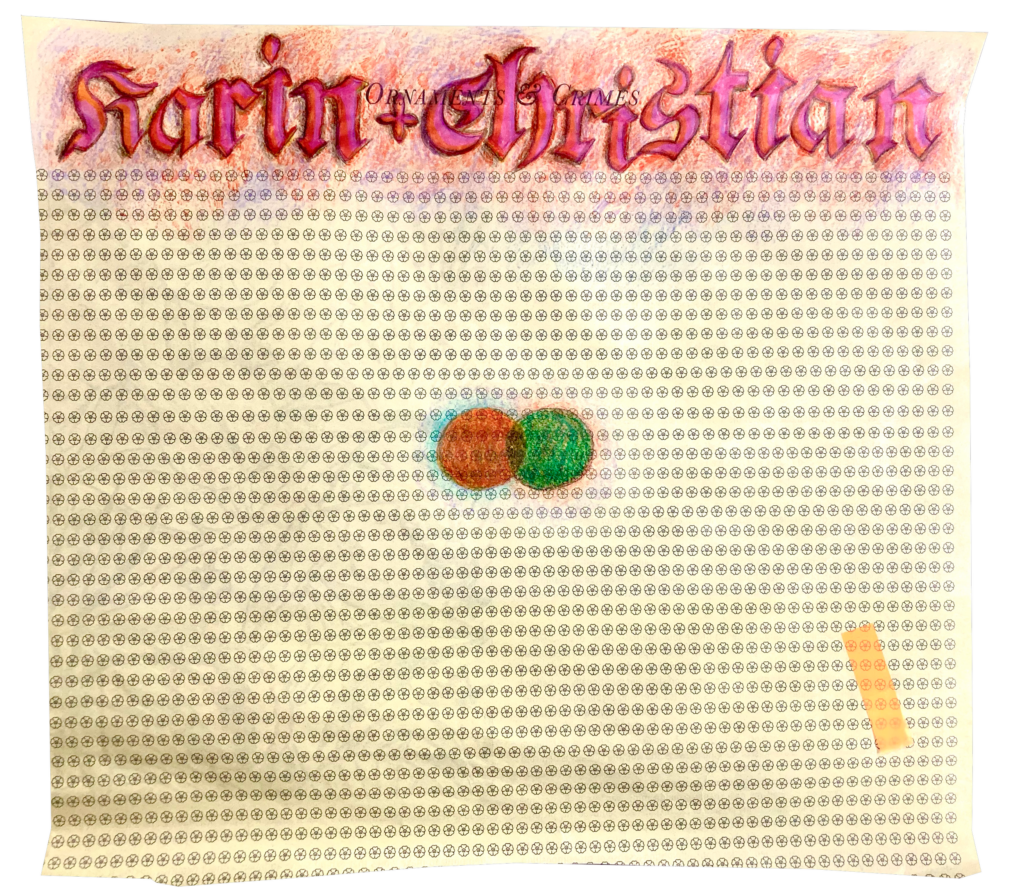
My hearing started to worsen about ten years ago. Prior to admitting my declining hearing, I thought holistic approaches can be an alternative instead of medical ones, so I try to exercise my focus through meditation. Right attempt to take, for the wrong reason: to expect that it’s a way out.
Expectation. It’s one of the issues I’ve learned through meditating. Who ever lives without expectation? It is human nature to expect, hope, and wish. It’s what keeps us alive. It might make us dead as well when not done on the right dose, though.
About six years ago, I learned to meditate. Just like most people, I thought it’s about sitting quietly and your mind will be at peace.. This course called Vipassana felt like a slap in my face that told me I was wrong, big time. The teachers taught me to be aware of the breath, to observe the ebb and flow of the mind; to walk through the process of facing myself. It literally makes me absorb the sentence “sit with it”.
When I first learn to meditate, I expect something will happen to my focus or whatsoever—then BAM!—I can recover the way I was, as if nothing happened. Back of my mind said: of course it doesn’t work that way, you fool. If it happens as easy as it is, there will be no suffering and there will be no hospital needed to cure any illness. If I go back to my former hearings that easily, I might keep taking for granted what my physical sense does to me. That’s why the teacher simply said “do not expect anything.”
Every human body has its own system and is working hard to function. Isn’t it a miracle itself? I never really thought of it before. To notice that my body works properly: I am able to take a long deep breath, to stretch my muscle, to do any pose I want, to walk anywhere I want, to process anything happening to and around me, to observe and regulate anything happening inside me, to express what I feel. I never really thought of it before, of how precious those things are. Despite what I lack, I still have more.
Karin

When we are used to miracles, we never see it as something special anymore. Just like we were told that we’re special, then every child who is told the same is also special. Then what’s so special about being special? Maybe that’s the point. We stop appreciating the miracles in ourselves. We chase other things, thinking that would satisfy us and make us happy—while our inner self tells us otherwise.
Tinnitus are different for everyone. Therefore, different people cope differently.
Most days, I spend my waking hours doing things while noticing my ringing head. I notice it stubbornly rings over any sound that comes into my head. I speak to others, their voices are overlaid by rings. I play music, and my hearing only catches particular sounds so it doesn’t sound whole to my head—and my brain makes up those rings to fill the void. I read somewhere that tinnitus is not a hearing issue, but more about brain nerve issue. Our brain has a default task of surviving, so it’s only natural for it to signal us if anything is wrong. Ironically, its attempt to save us from any trouble has made itself a threat for our very self.
These ringings can be lethal to mental health. Tinnitus is also called “phantom sounds” where nobody but the afflicted can hear. It feels isolating, anxiety-laden and no significant medical help. When one cannot escape, some people can ignore it, some surrender. Some others like me, gotta regulate because giving up is not an option.
My hearing might deteriorate but I learn from Deaf fellows that they are undeterred, so I will do too.
For a long time, I have been drawing mainly as my internal outlet. Drawing has been my ultimate activity since I was a kid. As a Jakartan growing up in the nineties, J-pop culture has a big influence over here—for me, it’s mainly manga that shapes and influences me a lot, especially on the way I draw and think.
Manga is the first long format that taught me about the infinite possibility of human imagination. Manga captured the emotions, visual possibilities, and exposed many topics in a way only them can do. From the simple storytellings, full with wisdom or reflections, historical or political, complex storyline, plain absurd, abstract; its charms are endless.
To think about it, the lasting impression for me comes from some manga that tells stories about daily life. The way they draw and spotlight the stories; jokes, food, books or mistakes done by the character; they all seem so human and feel relatable. Different from reading other manga genres, It makes us the readers feel..belong.
After I don’t draw much and shift to collage, the visuals and storytelling techniques of manga linger longer even until my current artworks; including the concept of fragments, diptych, and non-sequitur. It feels like any subtle feelings or moments can be immortalised in one frame—basically the same idea of mark-making, isn’t it?
Karin
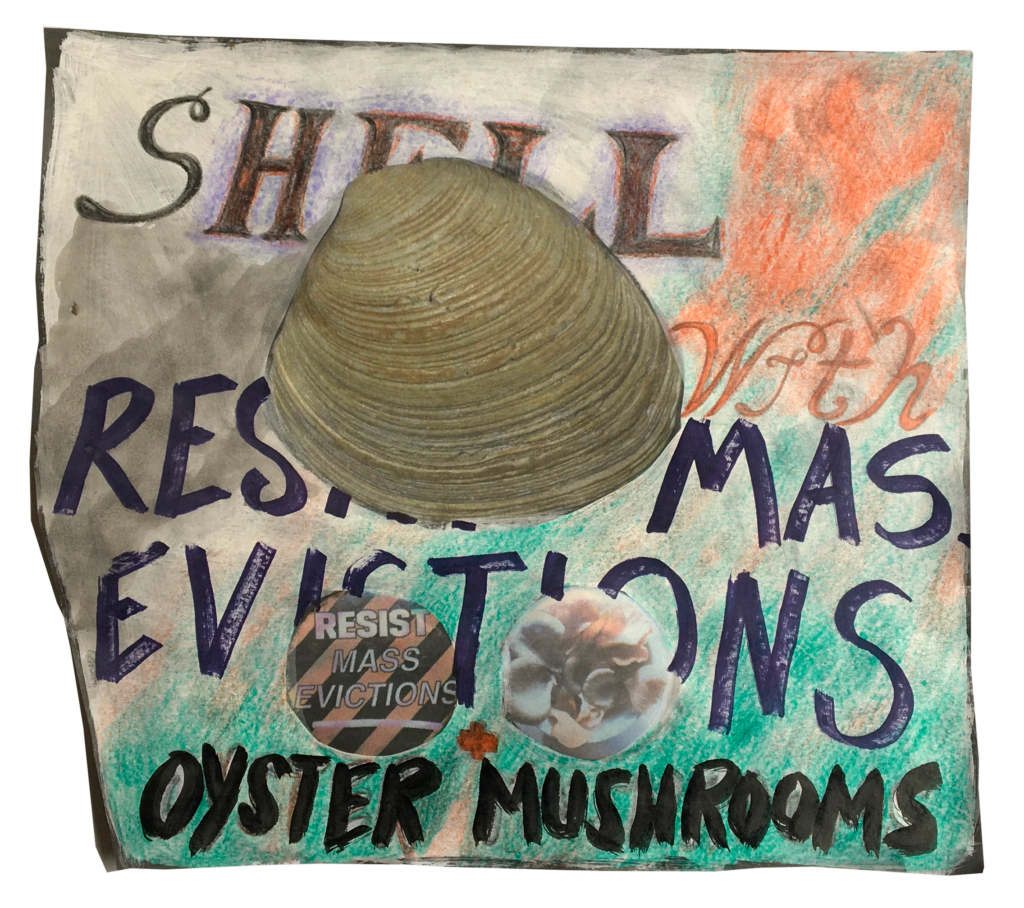
It’s about to feel like we belong. To see over the banal things, to read between the lines; that we’re meant to be here. To be acknowledged and to be kind to each other and our own self.
As a newbie artist, I still have to research a lot about the contemporary art. Coming from collage and abstract background, I found it refreshing to learn various possibilities in concept, visual and materials that could be used. After reading and researching about Christian’s works, I wish I could sit in front of his works and admiring the details for long time. The term “mark-making” seems to be a connecting line between our works. Since the similarity doesn’t have to be in visual way, but it can be in an essence or spirit. It’s amazing that discipline, resilience, references, opinion and personal thoughts can be combined in one artwork; and I can find it in Christian’s works.
Karin
This collaboration forms part of the year long Art et al. X Ketemu project, funded by the British Council’s International Collaboration Grants.
Images Copyright: Karin Josephine, Christian Newby and Ketemu Project.
